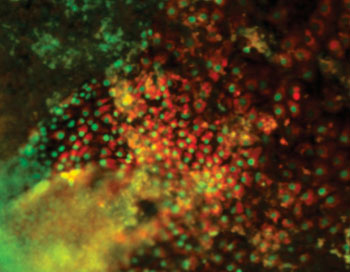Ready Source of Functional Liver Cells Should Boost Drug Development Efforts
By LabMedica International staff writers
Posted on 10 Aug 2015
Liver function in newborns kicks in only after exposure to certain nutrient factors derived from gut bacteria, and this phenomenon has been used to differentiate pluripotent stem cells into fully functional liver cells (hepatocytes). Posted on 10 Aug 2015
Investigators at the Hebrew University of Jerusalem (Israel) found that fetal hepatocytes acquired mature CYP450 (cytochrome P450) expression only after birth, suggesting that nutritional cues were required to drive hepatic maturation. Subsequently, they showed that vitamin K2 and lithocholic acid, a by-product of intestinal flora, activated pregnane X receptor (PXR) and CYP3A4 and CYP2C9 expression in isolated fetal hepatocytes.

Image: Photomicrograph shows emergence of stem cell-derived hepatocytes (Photo courtesy of Dr. Yaakov Nahmias, Hebrew University of Jerusalem, Israel).
Human pluripotent stem cells (hPSCs) represent an excellent source of differentiated hepatocytes; however, current protocols still produce fetal-like hepatocytes with limited mature function. In the current study, the investigators induced hPSCs to differentiate into fully functional mature hepatocytes by augmenting their growth medium with vitamin K2 and lithocholic acid.
They reported in the July 2015 issue of the journal Hepatology that differentiated cells produced albumin and apolipoprotein B100 at levels equivalent to primary human hepatocytes. Flow cytometry showed that over 83% of cells were albumin and hepatocyte nuclear factor 4 alpha (HNF4α) positive, which permitted high-content screening in a 96-well plate format. Stem cell–derived hepatocytes demonstrated all toxicological endpoints examined, including steatosis, apoptosis, and cholestasis, when exposed to nine known hepatotoxins.
“This is quite a revolution for pharmaceutical drug discovery,” said senior author Dr. Yaakov Nahmias, professor of bioengineering at the Hebrew University of Jerusalem. “While other groups have been able to produce liver cells before us, their cells showed little functional activity, and could not be reliably used for drug discovery. In fact, up until now stem cell-derived hepatocytes showed little ability to predict clinical outcome. The limited availability of functional hepatocytes for drug testing is a major bottleneck bringing pharmaceutical companies to spend USD one billion [per] year on liver cells alone. Our ability to produce an unlimited supply of functional liver cells from human pluripotent stem cells can change all that.”
Related Links:
Hebrew University of Jerusalem












